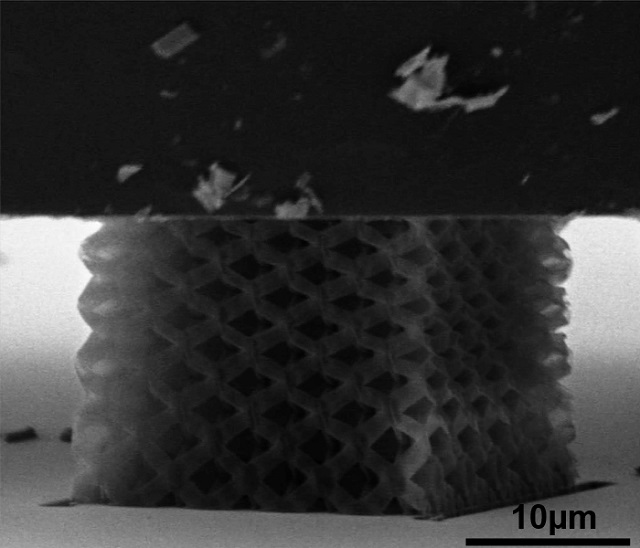 ceramic nanolattices Credit: Lucas Meza/Caltech
ceramic nanolattices Credit: Lucas Meza/Caltech
Solids demonstrate unusual properties at the nanoscale. Scientists at Caltech have utilized this property to construct new materials with 3D ceramic nanolattices.
Julia Greer, a Caltech professor of materials science and mechanics, states that utilizing the nanoscale concept for creating structures and then using the LEGO concept for building bigger materials will enable creation of materials with any set of desired properties.
A method call two-photon lithography, a direct laser writing technique was used by the researchers for “writing” a 3D pattern in a polymer by permitting a laser beam to harden and cross link the polymer at the targeted areas.
The polymer sections unexposed to the laser dissolved leaving behind the exposed sections forming a 3D scaffold. This scaffold could be coated with nearly any type of material, such as metals, semiconductors, or glass. The polymer within the structure was then etched out using a different technique, which resulted in a hollow architecture. This method could also be used to produce bones, by making a scaffold made of biocompatible materials on which cells could grow.
You deform it, and all of a sudden, it springs back. In some cases, we were able to deform these samples by as much as 85 percent, and they could still recover.
Caltech materials scientist Julia Greer
Employing this technique, the researchers utilized a repeating nanoscale pattern to form 3D nanolattices. Then the scaffold was coated with alumina ceramic. This led to hollow-tube alumina structures with tubes of diameter 450 to 1380nm and thickness of 5 to 60nm.
Greer and her team then wanted to test the mechnaical properties of the various nanolattices they created. Using two different devices for poking and prodding materials on the nanoscale, they squished, stretched, and otherwise tried to deform the samples to see how they held up.
They found that when compressed, samples that had 50nm wall thickness and 1µm diameter shattered. However, when samples that had a lower wall thickness to tube diameter ratio were tested, the compressed, deformed samples sprung back to their original shape.
Most brittle materials have flaws such as inclusions and voids that cause the material to shatter. If the material was perfect then it would not have weak spots. The researchers deduced that when structures were created with individual walls having a thickness of only 10nm, it reduced the size and number of flaws, and in effect it minimized the chances of the structure’s failure.
The researchers are presently trying to scale up production of these metamaterials.
This study has been published in the journal Science.
References